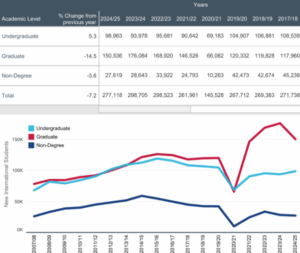
BY MARYANA AVERYANOVA
New data show a 17 percent drop in new international student enrollment in U.S. colleges this fall, signaling growing concerns across higher education about the country’s ability to attract global talent.
That decline arrives even as President Donald Trump recently declared that foreign students are “essential” to U.S. institutions, warning that cuts would “destroy U.S. colleges,” according to Bloomberg.
Yet for many students, the political rhetoric and lived reality feel increasingly disconnected.
One international student from Central Asia, who like the other students quoted here asked to be quoted anonymously, posted publicly that she traveled home this summer to renew documents and visit family before her final semester in the USA. Weeks later, she discovered her Student and Exchange Visitor Information System (SEVIS) record had been terminated and her next visa appointment pushed months ahead. With only one semester remaining, losing her active status rendered her ineligible for post-graduation work options as Optional Practical Training (OPT), a program that allows international students to work temporarily in the U.S. after graduation.
Her story is one of the issues fueling this year’s enrollment decline. All those problems, including visa delays, unpredictable travel outcomes are leading to a growing fear that studying in the United States has become less stable and less accessible.
According to Open Doors data, published by the Institute of International Education, the number of international students enrolled in U.S. higher education has been shrinking, contributing to the sharp decline this year in new enrollments.

A computer science major from Kazakhstan described spending nearly all of July consumed by worry that he would be unable to return to the U.S. after his visit home. “Every day felt like ‘what if?’” he said. “What if the rules change while I’m abroad? What if I lose everything I’ve worked for?” Though he returned this fall, the stress remains as he prepares for graduation.
The financial burden of studying in the U.S. adds another layer of pressure. An Albanian student said the high cost of international tuition makes even small policy changes risky. “The fees are too expensive, and we can’t work off-campus. One rule change could ruin everything.”
A student from Kyrgyzstan suggested the current climate may push more students toward Europe or Canada. “It’s already very expensive to study here, and jobs are limited,” she said. “If the rules keep getting more complicated, people will choose other countries.”
Some students compare the U.S. to other education systems and see differences. A Turkish student who previously studied in Argentina said the U.S. academic experience felt easier, but the immigration and job pathways weren’t stable. A Ukrainian student, educated in Europe and the U.S., said European programs offered better academic standards, while the U.S. offered post-graduation job potential but only if immigration pathways remained open.
Not all students expressed concern. An Albanian student pursuing an employment-based green card (EB-3) said he believes legal immigration pathways remain intact. “As long as students follow the rules, they should still have opportunities,” he said.
Across these varied voices, students described constantly monitoring policy changes, concerned that a single update could disrupt years of academic and financial planning.
According to NAFSA, international students contributed more than $43 billion to the U.S. economy last academic year. With enrollment declining and confidence shaken, colleges that rely on international tuition may face an increasingly uncertain future.
For many students, the challenge now is simply getting through their studies while managing the possibility that their entire plan could change overnight. “I want to stay,” the Kazakhstan student said, “but sometimes it feels like my future changes every time the news changes.”
